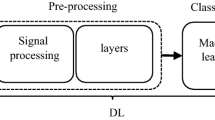Abstract
Anomaly detection is a typical task in many fields, as well as spectrum monitoring in wireless communication. Anomaly detection task of spectrum in wireless communication is quite different from other anomaly detection tasks, mainly reflected in two aspects: (a) the variety of anomaly types makes it impossible to get the label of abnormal data. (b) the complexity and the quantity of the electromagnetic environment data increase the difficulty of manual feature extraction. Therefore, a novelty learning model is expected to deal with the task of anomaly detection of spectrum in wireless communication. In this paper, we apply the deep-structure auto-encoder neural networks to detect the anomalies of spectrum, and the time–frequency diagram is acted as the feature of the learning model. Meanwhile, a threshold is used to distinguish the anomalies from the normal data. Finally, we evaluate the performance of our models with different number of hidden layers by our experiments. The results of numerical experiments demonstrate that a model with a deeper architecture achieves relatively better performance in our spectrum anomaly detection task.










Similar content being viewed by others
References
Chandola V, Banerjee A, Kumar V (2009) Anomaly detection: a survey. ACM Comput Surv 41(3):1–58
Aleskerov E, Freisleben B, Rao B (1997) Cardwatch: a neural network based database mining system for credit card fraud detection. In: Computational Intelligence for Financial Engineering (CIFEr), 1997, Proceedings of the IEEE/IAFE 1997, IEEE, pp 220–226
Kumar V (2005) Parallel and distributed computing for cybersecurity. IEEE Distrib Syst Online 6(10):1
Spence C, Parra L, Sajda P (2001) Detection, synthesis and compression in mammographic image analysis with a hierarchical image probability model. In: IEEE Workshop on Mathematical Methods in Biomedical Image Analysis, 2001. MMBIA 2001. IEEE, pp 3–10
Bertini M, Del Bimbo A, Seidenari L (2012) Multi-scale and real-time non-parametric approach for anomaly detection and localization. Comput Vis Image Underst 116(3):320–329
Khazai S, Safari A, Mojaradi B, Homayouni S (2013) An approach for subpixel anomaly detection in hyperspectral images. IEEE J Sel Top Appl Earth Obs Remote Sens 6(2):769–778
Quinn JA, Sugiyama M (2014) A least-squares approach to anomaly detection in static and sequential data. Pattern Recognit Lett 40:36–40
Goernitz N, Braun M, Kloft M (2015) Hidden markov anomaly detection. In: Proceedings of the 32nd International Conference on Machine Learning (ICML-15), pp 1833–1842
Bigdeli E, Mohammadi M, Raahemi B, Matwin S (2015) A fast and noise resilient cluster-based anomaly detection. Pattern Anal Appl 20(1):183–199
LeCun Y, Bengio Y, Hinton G (2015) Deep learning. Nature 521(7553):436–444
Hinton GE, Osindero S, Teh YW (2006) A fast learning algorithm for deep belief nets. Neural Comput 18(7):1527–1554
Marchi E, Vesperini F, Eyben F, Squartini S, Schuller B (2015) A novel approach for automatic acoustic novelty detection using a denoising autoencoder with bidirectional LSTM neural networks. In: Proceedings of the 2015 IEEE International Conference on Acoustics, Speech and Signal Processing (ICASSP), IEEE, pp 1996–2000
Marchi E, Vesperini F, Weninger F, Eyben F, Squartini S, Schuller B (2015) Non-linear prediction with LSTM recurrent neural networks for acoustic novelty detection. In: Proceedings of the 2015 International Joint Conference on Neural Networks (IJCNN), IEEE, pp 1–7
Sakurada M, Yairi T (2014) Anomaly detection using autoencoders with nonlinear dimensionality reduction. In: Proceedings of the MLSDA 2014 2nd Workshop on Machine Learning for Sensory Data Analysis, ACM, p 4
Espi M, Fujimoto M, Kinoshita K, Nakatani T (2015) Exploiting spectro-temporal locality in deep learning based acoustic event detection. EURASIP J Audio Speech Music Process 2015(1):26
Liu S, Greenstein LJ, Trappe W, Chen Y (2012) Detecting anomalous spectrum usage in dynamic spectrum access networks. Ad Hoc Netw 10(5):831–844
Qiu J, Wu Q, Ding G, Xu Y, Feng S (2016) A survey of machine learning for big data processing. EURASIP J Adv Signal Process 2016(1):1–16
Hayes MA, Capretz MA (2015) Contextual anomaly detection framework for big sensor data. J Big Data 2(1):1
Ngiam J, Coates A, Lahiri A, Prochnow B, Le QV, Ng AY (2011) On optimization methods for deep learning. In: Proceedings of the 28th International Conference on Machine Learning (ICML-11), pp 265–272
Chopra P, Yadav SK (2015) Fault detection and classification by unsupervised feature extraction and dimensionality reduction. Complex Intell Syst 1(1–4):25–33
Ng A (2011) Sparse autoencoder. CS294A Lect Notes 72:1–19
Hochreiter S, Bengio Y, Frasconi P, Schmidhuber J (2001) Gradient flow in recurrent nets: the difficulty of learning long-term dependencies. In: A Field Guide to Dynamical Recurrent Neural Networks, IEEE Press
Bengio Y, Lamblin P, Popovici D, Larochelle H et al (2007) Greedy layer-wise training of deep networks. Adv Neural Inf Process Syst 19:153
Poultney C, Chopra S, Cun YL, et al (2006) Efficient learning of sparse representations with an energy-based model. In: Advances in Neural Information Processing Systems, pp 1137–1144
Acknowledgements
This work was supported by the National Natural Science Foundation of China (NSFC) (No. 61671167, Research on a new method for Dynamic Spectrum Access (DSA) with high efficiency base on SMSE model and its channel suitability) and the Key Development Program of Basic Research of China (No. JCKY2013604B001). And we would like to thank Chunmei Li and Guangzhen Si for their helpful comments.
Author information
Authors and Affiliations
Corresponding author
Rights and permissions
About this article
Cite this article
Feng, Q., Zhang, Y., Li, C. et al. Anomaly detection of spectrum in wireless communication via deep auto-encoders. J Supercomput 73, 3161–3178 (2017). https://doi.org/10.1007/s11227-017-2017-7
Published:
Issue Date:
DOI: https://doi.org/10.1007/s11227-017-2017-7




